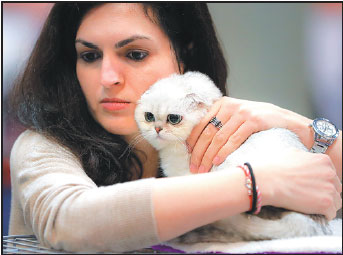DNA shows early spread of cats in human world
|
A woman holds a cat in Bucharest, Romania. Scientists believe the domestication of cats began about 10,000 years ago.Vadim Ghirda / Associated Press |
NEW YORK - Long before cats became the darlings of Facebook and YouTube, they spread through the ancient human world.
A DNA study reached back thousands of years to track that conquest and found evidence of two major dispersals from the Middle East, in which people evidently took cats with them. Genetic signatures the felines had on those journeys are still seen in most modern-day breeds.
Researchers analyzed DNA from 209 ancient cats as old as 9,000 years from Europe, Africa and Asia, including some ancient Egyptian cat mummies.
"They are direct witnesses of the situation in the past," said Eva-Maria Geigl of the Jacques Monod Institute in Paris. She and colleagues also looked at 28 modern feral cats from Bulgaria and east Africa.
It's the latest glimpse into the complicated story of domesticated cats. They are descendants of wild ancestors that learned to live with people and became relatively tame though some cat owners would say that nowadays, they don't always seem enthusiastic about our company.
The domestication process may have begun around 10,000 years ago when people settled in the Fertile Crescent, the arch-shaped region that includes the eastern shore of the Mediterranean Sea and land around the Tigris and Euphrates rivers. They stored grain, which drew rodents, which in turn attracted wildcats.
Animal remains in trash heaps might have attracted them too. Over time, these wild felines adapted to this man-made environment and got used to hanging around people.
A previous study had found a cat buried alongside a human some 9,500 years ago in Cyprus, an island without any native population of felines. That indicates the cat was brought by boat and it had some special relationship to that person, researchers say.
Cats were clearly tame by about 3,500 years ago in Egypt, where paintings often placed them beneath chairs. That shows by that time, "the cat makes its way to the household," said Geigl.
In the DNA samples analyzed, one genetic signature found first in the Asian portion of Turkey and perhaps once carried by some Fertile Crescent cats showed up more than 6,000 years ago in Bulgaria.
That indicates cats had been taken there by boat with the first farmers colonizing Europe, Geigl said. It also appeared more than 5,000 years ago in Romania, as well as around 3,000 years ago in Greece.
A second genetic signature, first seen in Egypt, had reached Europe between the first and fifth centuries, as shown by a sample from Bulgaria. It was found in a seventh-century sample from a Viking trading port in northern Europe, and an eighth-century sample from Iran.
The dispersal of the cats across the Mediterranean was probably encouraged by their usefulness in controlling rodents and other pests on ships, the researchers said.
Associated Press



















